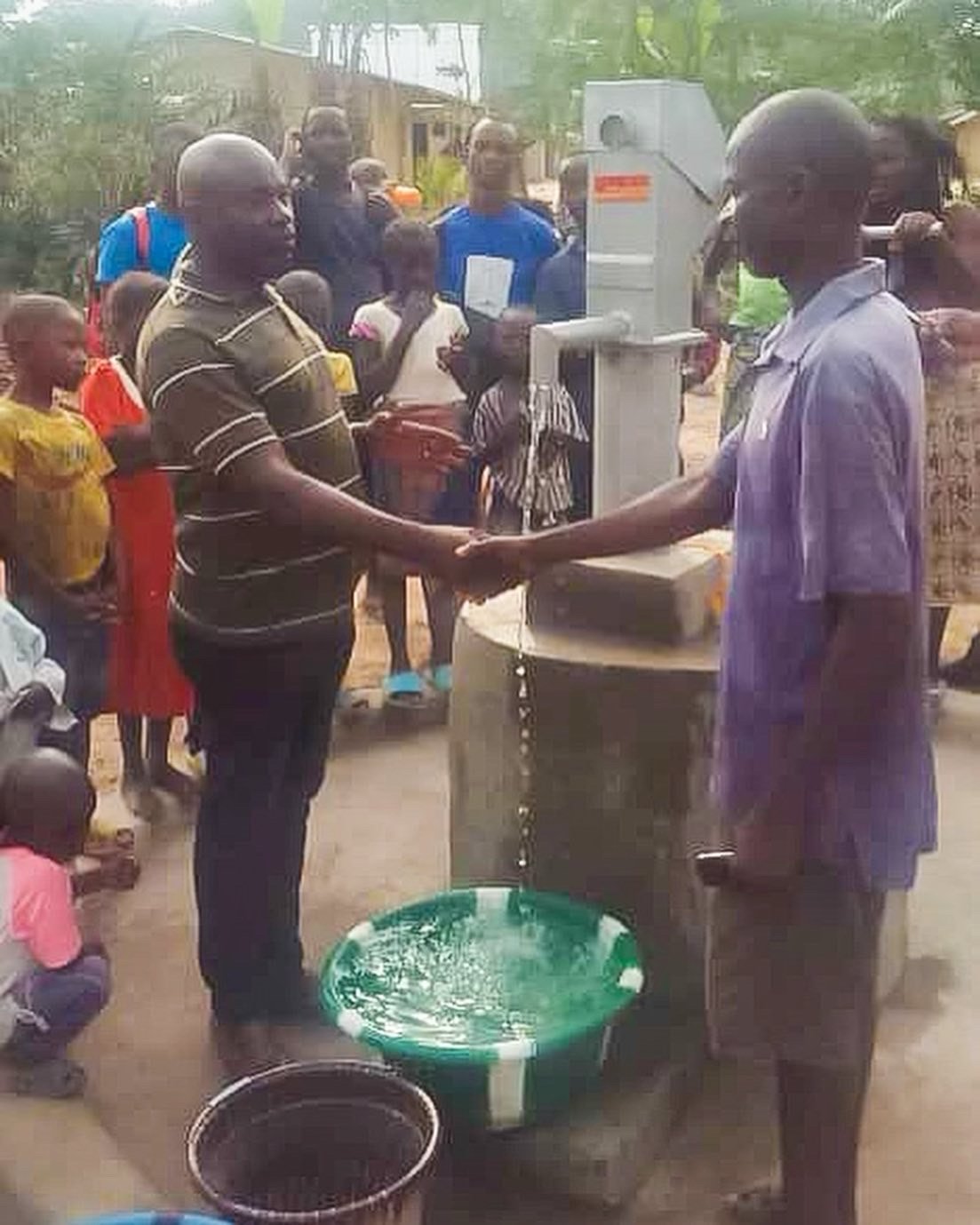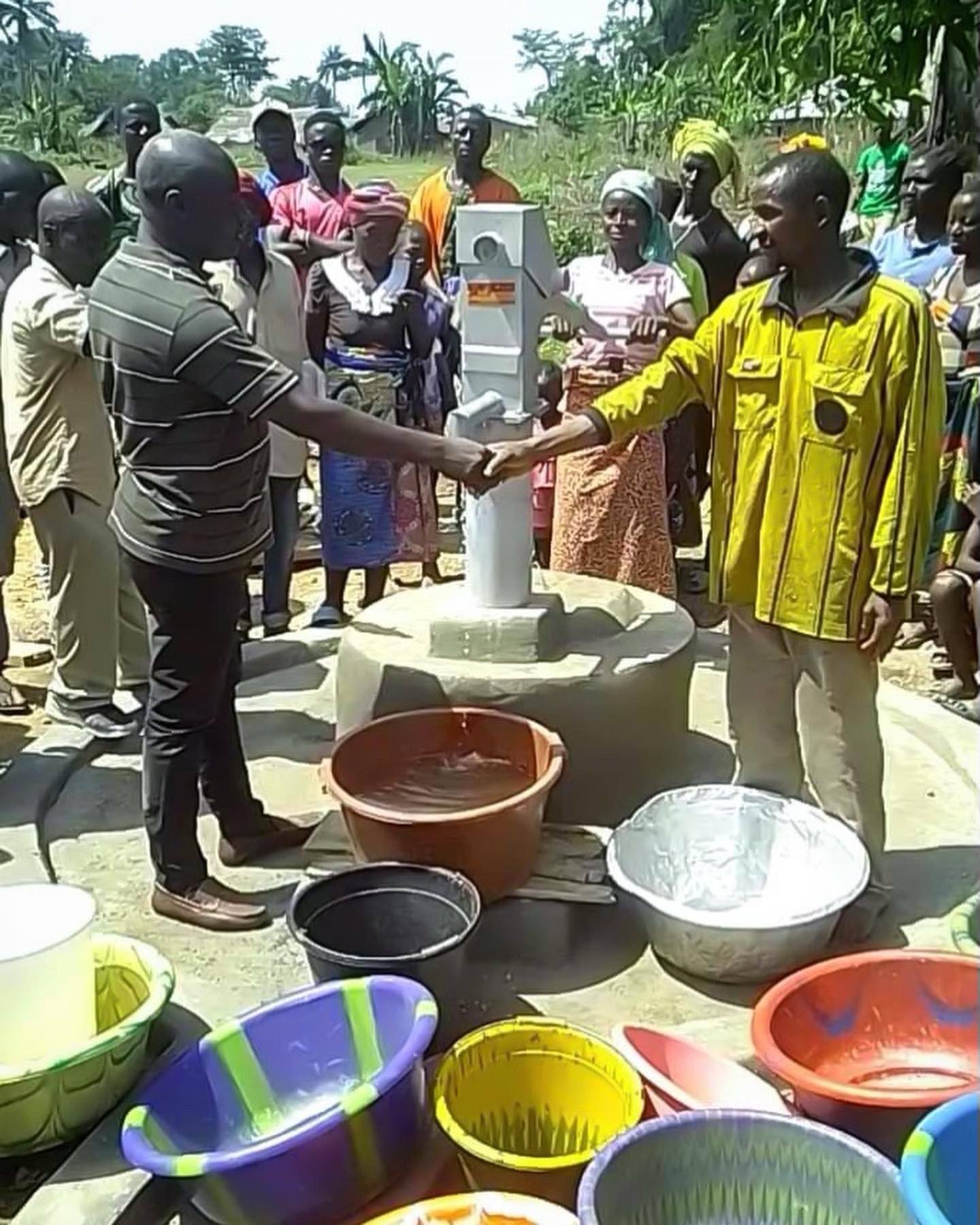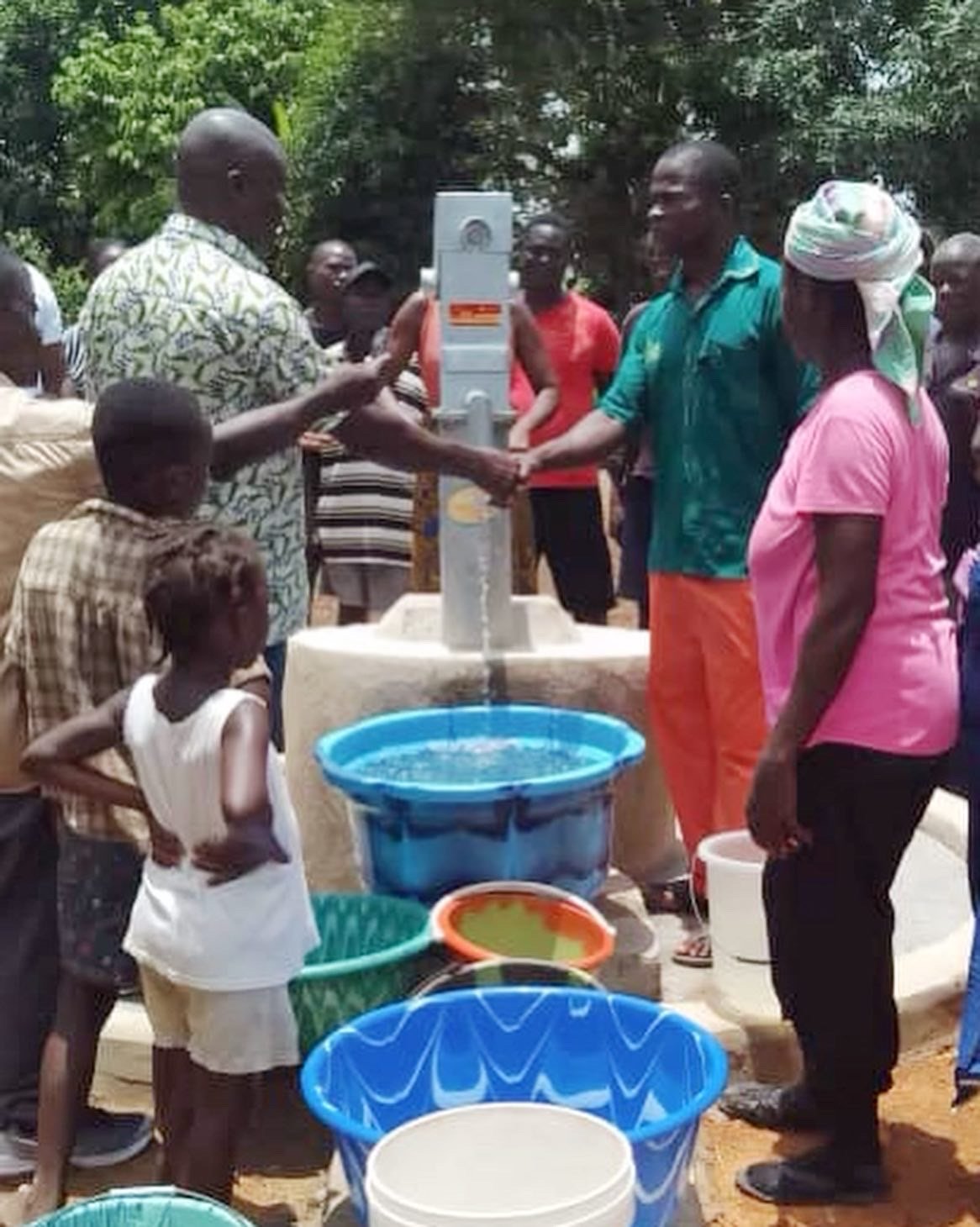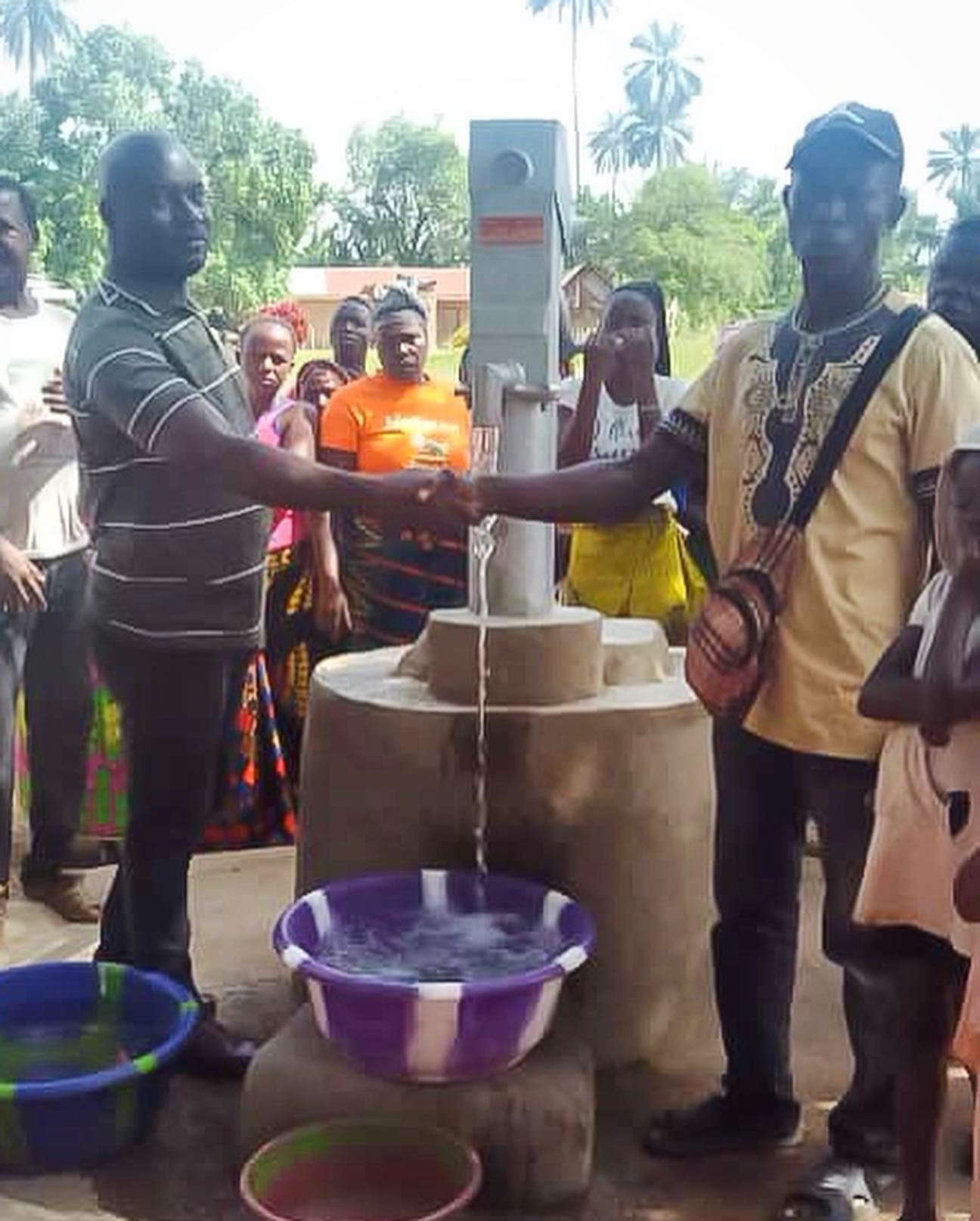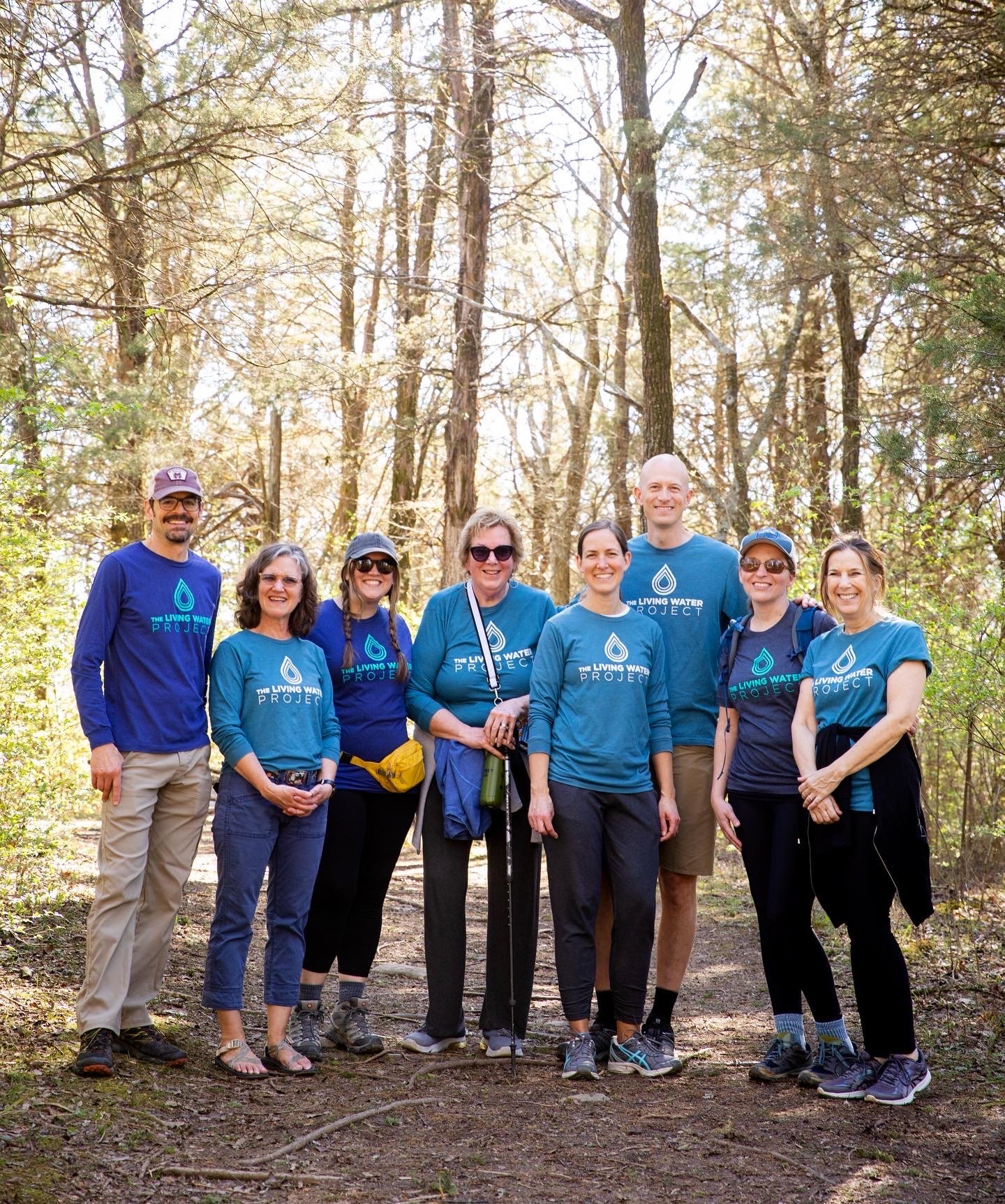Take a moment and listen to this message from our on-the-ground partner in Zambia, Shadreck Sibwaalu:
Zoom in on Zambia
The 2023 "Zoom in on Zambia" campaign kicks off on Monday, July 17th. Our goal this year is to raise $40,000 and we are asking for your help, once again. Would you consider donating early to this year's campaign? Every dollar matters!
Thanks to your generous contributions towards our Zambia campaigns in past years, you have helped us fund 168 wells, which provide nearly 60,000 people with clean water. We are so grateful!
Thank you in advance for helping to make a difference in the lives of Zambians who need clean water! Remember, The Living Water Project is an all-volunteer organization with ZERO overhead. EVERY dollar you give goes directly to provide clean water to people who don't have it.
To make a contribution, click here.
Scenes from a recent LWP-funded well in Siluyasila Village, Zambia
Five Wells in Liberia Completed
There are now FIVE NEW WELLS in Liberia! Each of these was funded by donations to The Living Water Project and completed in March 2023 through our partnership with Alfred Beyan:
1. Mbamhu Community, Lofa County
2. Bortorsu Community, Lofa County
3. 15 Gate Community
4. Mbamahum Community, Lofa County
5. Halaya Town, Lofa County
Worth noting: we recently approved FIVE ADDITIONAL WELLS in Liberia. Praise God for these answered prayers and for Alfred’s life-changing work in these communities.
Nine New Wells!
A total of $38,240 in funding has been approved by the Living Water Project board for NINE NEW WELLS: five in Liberia and four in Ghana. Construction will begin shortly!
As always, we are grateful for the generous donors who help make these clean water projects possible. THANK YOU!
The #LWPchallenge2023
Beginning today and continuing through World Water Day on Wednesday, The Living Water Project board is challenging you to WALK (or bike/run/drive) 3.7 miles, DONATE at least $9 to give clean water access to one person, and then SHARE a photo or video of yourself completing the challenge with the hashtag #LWPchallenge2023, calling on three friends to do the same.
Together we hope to raise over $50,000 to drill 10 new wells and prevent thousands of people from having to make that long journey for clean drinking water every day. #worldwaterday2023
Members of The Living Water Project board who recently made the 3.7 #lwpchallenge2023 at Marcella Viverette Smith Park in Brentwood, TN.
Why 3.7 miles? Because that’s the average daily distance women in africa walk to collect and carry water for their families.
We ask that you donate at least $9, but here are some examples of different levels at which you can give, should you decide to contribute more.
Challenge someone on social media or simply via text thread to do the same!
Join the #Challenge to Walk For Yamah
Yamah is a teenage girl who lives in a remote village in Liberia. Her lifelong dream is to go to school. She’d like to learn a skill so she can earn money to buy more food for her family. With such a large family, there just never seems to be enough for everyone. She’d like to help fix that problem.
Right now, though, Yamah is watching her dream slip slowly away. She’s almost too old for school, and she’s never been able to go because she must spend so much time collecting water for the family. Someone in the family has to make several trips a day to a shallow, hand-dug well that’s almost a quarter of a mile from Yamah’s house. In Yamah’s village, that job has always fallen to the family’s oldest daughter—Yamah.
That means Yamah must walk about 3.7 miles a day just to get enough water for the family to survive. And survive is about all they do. That shallow well is little more than a mud puddle. The water is cloudy and dirty. Someone in Yamah’s family is almost always sick with diarrhea.
Yamah’s story is repeated far too often in developing nations. Millions of young women around the world have to work as hard as she does, walking long distances to haul heavy loads of water that’s just barely clean enough to keep their families alive.
Please help us observe World Water Day on March 22 by joining in the Living Water Challenge to walk for Yamah—to raise money to provide clean water to Yamah’s family, their village, and thousands of other villages around the world. Here’s how you can help:
Walk 3.7 miles for Yamah. Do it your own way— walk, hike, bike or run. Do it at your own pace on your own schedule and in any place you choose. Cover the 3.7 miles all at once or spread it out over several days. All we ask is that you spend the time thinking about the hardships endured by Yamah and praying for her and millions of other people around the world as they walk that far every day just to get enough water to survive.
Donate at least $9 to The Living Water Project. Think in terms of one of these amounts:
• $9 provides water for one person.
• $99 provides water for two families.
• $999 provides a rehabilitated well for one village.
• $9999 provides new wells for two villages.
Share this effort with others. On social media or simply a text thread, share a photo or video of yourself on the 3.7-mile journey and challenge three friends to do the same. If posting on social media, use the hashtag #lwpchallenge2023 so we can follow the progress!
If public participation isn’t your style, that’s okay. We simply and humbly ask that you give. The more money and awareness we can raise, the sooner we can change the lives of people who need clean water.
DONATE NOW
At the contaminated water source with buckets used for gathering and carrying water
Contaminated water used by the village
Access to Clean Water Can Prevent Child Trafficking
Amy Arnold is a long-time friend of The Living Water Project and recently shared a powerful story that is worth re-sharing here. With previous experience as a law enforcement officer, Amy is now a donation-supported missionary fighting human trafficking in Southern Africa. She trains law enforcement and non-profit organizations and works in the field, rescuing and supporting victims of human trafficking.
You can read more about her important work and lend your support at ArnoldsAbroad.com
THE POWER OF WATER by Amy Arnold
This is a story about a Dutch policeman, a boy from my childhood, and a precious friend from Lipscomb. The way in which the paths of these three people come together to serve “the least of these” is only possible in the creative mind of God. Only He could have woven this story together. As much as this is a story about my three friends, it really starts on the other side of the world with three young boys in Malawi.
Due to extreme poverty, most children in Malawi don’t have the luxury of going to school. They must search for work, but only the lucky ones actually find something to do. They work not only to provide for their families, but also to contribute to the whole village. Jobs are rare, so when one person can find work, the expectation is that they share the money with those around them.
It was a happy day in a certain Malawian village when three of their children were given the chance to work on a tobacco farm. Like most things too good to be true, there was a catch. The boys would not get paid until they had worked for 12 months. (Enter Gerco) Gerco is a colleague of mine, originally from the Netherlands who worked in Malawi fighting human trafficking. When he and his team became aware of this tobacco farm, eyebrows were raised, and they began to investigate. It didn’t take long before Gerco and his team were able to rescue one of the boys from the farm. While taking statements from him and his family members, the boy’s mother told Gerco that children had been working at the farm for 11 months. She asked if Gerco could wait just one more month before conducting a raid so that the boys would at least get paid for their year of work.
Now you, Gerco, and I can clearly see that the likelihood of those boys getting paid even after 12 months was slim to none. But you can’t blame the desperation of a mother clinging to hope. Unfortunately, waiting another month would endanger the remaining boys and give the farmer time to flee.
As hope was fading, the mother asked if Gerco could somehow compensate the village for the “lost” money since he was planning on rescuing the others before the 12 month mark. Gerco had compassion for her, but didn’t want to cover up a real problem with temporary money so he asked her, what would really help the village to ensure it’s children don’t get trafficked again. The mother answered, “water.” She said since they have to spend hours and hours everyday walking to fetch water, there was no time to do anything else. If they had water they could grow crops and raise cattle.
Gerco didn’t have an answer but told the mother he would think on it. A few days later he shared this story with me. He wasn’t looking for me to provide a solution but was just telling me about his latest case. As I was listening, I immediately thought of a childhood friend of mine. (Enter Jon) Jon is the president of an amazing organization called The Living Water Project. The Living Water Project is a non-profit organization that extends the love of Jesus by building water wells in impoverished areas all over the globe.
I contacted Jon to see if he thought there was the possibility of assisting this village. He said he would pass on the information to the rest of his team, but the timing was good because The Living Water Project had just approved a series of water wells in Malawi around a local hospital called Blessings Hospital. (Enter Sara) Sara was a dear friend of mine from our college days at Lipscomb. She had a heart for medical missions and after her death the Sara Walker Foundation was established to continue her legacy. Jon said if the village was near enough to the hospital, they could possibly tie an additional well into the same project.
My mind was blown, my old friend Jon at The Living Water Project was going to contact a hospital that is supported by my precious friend Sara’s foundation to see if they could provide water for a village in which my colleague Gerco had just rescued trafficking victims!
And, it worked! In the end, three boys rescued, one trafficker arrested, and a village now has clean water. Water to drink, to clean wounds, to wash, to farm, and to build lives that don’t force children into exploitation.
Oh how I continue to be in awe at the creativity of God and how He will weave paths together in the most inexplicable ways. Our only job is to be on the path He wants us on.
Amy Arnold
Living Water Project president Jon Lee and Amy Arnold
Spread the Word: Help Us Multiply These Year-End Gifts to the Living Water Project
Here in these last few weeks of the 2022, we are thrilled to announce some amazing year-end gifts to the Living Water Project (LWP):
• Inflo Design Group, a Franklin, Tenn.-based engineering firm specializing in water resources, has pledged $125,000 to our general fund.
• The Rieder family is funding a new well to a village in Ghana in honor of their son, Andrew. This well is slated for construction in early 2023. Read more about the Rieders’ sustained generosity to LWP in this blog post.
• A partner at a local Nashville law firm has gifted four new wells—two in Cameroon and two in the Republic of Chad—in honor of his employees. These wells, representing a total investment of $12,800, are also set to be built in early 2023. Clearly this is not just a gift for the honorees, but also for hundreds, potentially thousands, of people who are currently in desperate need of clean water.
Because of these inspiring gifts, we are more than halfway to our year-end giving goal of $250,000. We are so thankful—and even more confident we can reach our ambitious goal by Dec. 31!
Each year we receive more and more generous donations from businesses, churches and other organizations seeking to make a difference. We are thankful for these partnerships, and we challenge all of our friends to spread the word about LWP to your workplace, church and other groups in which you are involved. Whether you’re able to donate $5, $50 or $5,000, we are grateful you’re a part of our giving community.
You can be an important part of our clean water plans in 2023 by donating today—just click here.
Dinner Highlights Guatemala Water Project
THANK YOU to all who joined us at the LWP fundraising dinner on Oct. 25. We loved the chance to give you details on our 2022 work and our vision for 2023.
We were particularly proud to share the results of an enormous water project completed this year in Los Limones, Guatemala. This work was beautifully captured by a Garney Construction video, “Imagine a Day Without Water.” Go to our Instagram account to watch the reel, and read this blog post from Garney to learn more.
This amazing collaboration between Peugeot Center at Lipscomb University, our in-country partner ADICAY, Garney Construction and members of the community has meant hundreds of children and their families now have clean drinking water in their homes!
None of this work would be possible without your generosity! If you haven’t had a chance to donate to our fundraiser yet, it’s easy to give at THIS LINK.
We would be remiss if we didn’t express our appreciation to the many volunteers who helped behind the scenes of this year’s dinner. In no order:
J. Terry Bates & Associates for sponsoring the dinner
Jessica & Scott Schwieger
Michael O'Dell
Anne Rawlins
David & Dia Duer
Kevin Colvett
Stephen Jerkins
Mary Hearn
Erin Rickelton
Kathy & Terry Bates
Carolyn & Kerry Patterson
Chris & Don Portell
Greg Perry
Jim & Danna Arnett
Rebekah & Brad Glisson
Lynn & John Mott
Jim Glisson
Melissa & Michael Kirby
Jamie Roberts & Matt Schutz
David Knox
Linda Zelnik
A Taste of Guatemala: Recipes From the 2022 Living Water Project Dinner
If you attended our 2022 Celebration and Fundraiser Dinner on Oct. 25, part of the fun experience was sharing a meal inspired by the cuisine of Guatemala. Here is the menu and a couple of recipes that you can make at home. Enjoy!
Menu:
Pepián de pollo with rice (recipe below)
Tortillas
Salad
Tres Leches Cake
Cocoa Tea (recipe below)
Pepian with Pollo (Recipe by Luis Yanes, adapted from Familiakitchen.com)
Servings: 10
Prep Time: 25 min. Cooking Time: 1 hour, 15 min.
Ingredients:
1 whole chicken
water, to cover the chicken (around 5 cups)
1 Tbsp salt
Recado Sauce:
2 guajillo chiles - seeds and stem removed
2 ancho chiles - seeds and stem removed
6 Roma tomatoes
1/2 onion, large or 1 medium
5 to 6 cloves garlic
1 inch cinnamon stick
2/3 cup raw pumpkin seeds, shelled
2/3 cup sesame seeds
1/2 cup cilantro, packed, roughly chopped
1 lb string beans, fresh, trimmed
1 potato, large, peeled, cubed
2 guisquiles squash or chayotes, peeled, cubed
Directions:
Boil and Shred the Chicken:
● Place the whole chicken in a large pot and fill it with water to cover. Add the salt.
● Turn the burner to high, bring the water to a boil. Lower the heat to medium and let the chicken cook for 30 - 45 minutes.
● Skim off and discard any grey scum that may form while cooking.
● When done, set the pot with the chicken and its broth aside to cool.
● When cool to the touch, shred or cut the chicken into bite-size pieces and return to the pot with the chicken broth. “Traditionally, we only shred the chicken breast, and keep the thighs and legs of the chicken whole (bone-in),” says Luis.
Prep the Vegetables:
● Wash and trim the ends of the fresh string beans, leaving them whole.
● Peel and cut the guisquiles or chayote squash and the potato into small cubes.
● Boil vegetables until just cooked.
Make the Recado Base Sauce:
● Make on a hot cast-iron pan, griddle or comal set to medium high
● Dry roast the ancho and guajillo chiles for 1 or 2 minutes. Set them aside in a bowl.
● Dry roast (Char) the tomatoes, onions (skin on) and garlic until very well browned. The garlic will deepen in color, give off an aroma and be ready before the rest of the ingredients. Take them out and add them to the chiles in the bowl.
● When the tomatoes and onion start to blister, blacken and get fragrant, add them to the bowl.
● Place the dry-roasted chiles, tomatoes, onion, garlic and optional anise in a saucepan. Set the heat to medium high. Add water to cover and bring to a boil. When it boils, turn off the heat and set the saucepan aside to cool.
● Adjust the heat of the cast-iron pan, griddle or comal to low. Dry roast the pumpkin seeds until browned (not burned) about 5 minutes. When they start to give off a smoky aroma, they are ready (they will also pop). Set them aside in your bowl.
● Toast cinnamon stick until browned, not burned.
● Dry roast the sesame seeds for 3 to 5 minutes, until they turn pale gold. Keep an eye on them: they can go from toasted to burnt quickly. Add them to your bowl.
● Process the toasted seeds and cinnamon stick in a spice grinder or food processor until they are a very fine powder. You'll need to pulse several times to get the mixture fine enough.
● Scoop out the chiles, tomatoes, onion, and garlic plus about 1⁄2 cup of their liquid into a blender; process until smooth. Add the toasted pumpkin and sesame seeds and cinnamon powder and cilantro.
● Blend—until the mixture completely disintegrates. You will have an orange-reddish, nutty and full-flavored recado sauce.
● Add at least 4 cups of broth and process until smooth
● Strain the recado sauce in batches through a colander if there are any pieces left. Throw away any small scraps of vegetables, seeds and spices left behind in your colander
Putting It All Together:
● Combine sauce, chicken and possibly more broth in pot, Stir to mix well. Set the heat to medium high. When the stew comes to a boil, reduce the heat to medium low.
● Let the stew simmer and reduce for 10 to 15 minutes, uncovered. (add more water or broth if you want a thinner consistency
● Add the pre-cooked string beans, guisquiles or chayote, and potato to the pot. Stir to combine.
● Serve with white rice, hot tortillas and wedges of fresh avocado on the side.
The consistency of pepian is like a soup: liquidy, Luis says. If your recado is too thick when it comes out of the blender, thin it out by adding a little of the chicken broth. Then pass it through a strainer in batches so that only the liquid goes into the pot with the cooked chicken.
*****
Cacao Husk Tea (recipe from The Spice Jungle)
Cacao husks are the fibrous shells surrounding cacao beans, separated from the cacao nibs during production.
Prep Time: 15 mins
Equipment: French Press OR tea infuser (tea ball or tea pot with infuser basket)
Ingredients:
2 tsp Nacional Cacao Husks per person
1 cup Boiling water per person
Instructions:
If using a French press, add cacao husks and pour in boiling water, then cover.
If using tea ball or infuser basket, try to cover cup or pot while steeping. It's important to keep the water as hot as possible to fully extract the cacao flavor.
Allow tea to steep for 6 to 8 minutes. If you intend to add milk or cream, steep at least 10 minutes.
For French press, slowly depress plunger. Otherwise, remove infuser ball or basket. Pour into serving cups. Add milk/cream and sweetener, if desired.



